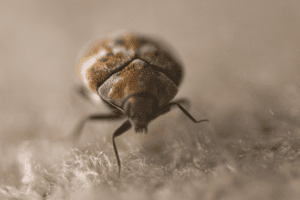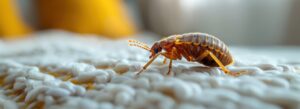Carpet beetles may be tiny, but they can cause outsized problems for homes and businesses across Kent. Known scientifically as members of the Dermestidae family, these pests feed on natural fibres such as wool, silk, and cotton. Left unchecked, they can ruin carpets, upholstery, clothing, and even stored products like cereal or flour.
At Innovation Pest Control, one of the most common questions we’re asked is:
What causes carpet beetles?
It’s an important question, because the causes explain not only why infestations begin, but also how to stop them from returning. This guide covers everything: from the entomology of carpet beetles to the conditions they thrive in, the species you’ll find in the UK, and the prevention measures that really work.
What Are Carpet Beetles?
Carpet beetles (often referred to as carpet beetles) are small insects that thrive in homes, businesses, and storage areas. The most common species in Kent and the wider UK include:
- Varied carpet beetle (Anthrenus verbasci) – distinctive with patterned scales, commonly found in homes.
- Furniture carpet beetle (Anthrenus flavipes) – oval shaped, with yellowish scales.
- Black carpet beetle (Attagenus unicolor) – dark coloured, slightly larger.
- Common carpet beetle (Anthrenus scrophulariae) – found near windowsills and feeding on wool or silk.
These insects belong to the order Dermestidae, a family well-studied in entomology because of their ability to damage textiles and even preserved museum specimens.
While adults mainly feed on pollen and nectar, the larvae are destructive. Their diet includes wool, silk, cotton, pet hair, dead insects, taxidermy mounts, and even organic matter like feathers or rodent remains.
Life Cycle: How Carpet Beetles Multiply
Understanding what causes carpet beetles starts with their life cycle.
- Egg – Female carpet beetles lay dozens of eggs in dark, undisturbed places such as under furniture, inside a closet, or near skirting boards.
- Larvae – The most destructive stage. Carpet bug larvae chew through fibres, leaving holes, frays, and debris such as shed skins and feces. They may go through multiple moulting cycles before pupating.
- Pupa – The larvae transform into pupae, often hidden deep within carpets or upholstery.
- Adult – Adults emerge and often fly towards light sources, windows, or fresh flowers.
Environmental factors like temperature, humidity, and availability of oxygen-rich air directly affect how fast this cycle completes.
What Causes Carpet Beetles? The Main Culprits
Now let’s break down the true causes of carpet bug infestations:
1. Access Points in Buildings
Carpet beetles enter homes through gaps in walls, vents, chimneys, and doors. In Kent, where many properties are historic, tiny cracks are a frequent cause.
2. Bird and Wasp Nests
Old nests provide food (feathers, insect remains, and organic matter). Many infestations we treat in Canterbury, Ashford, and Maidstone trace directly back to loft nests.
3. Stored Fabrics and Natural Fibres
Carpet beetles thrive on natural fiber materials: wool carpets, silk curtains, cotton clothing, fur coats, and upholstery. Items stored without protection—especially in a closet or attic—are prime targets.
4. Food Sources Indoors
Carpet beetles will attack pet food, seeds, flour, and cereal if left unsealed. They’ll also feed on dead insects, spider webs, or even rodent carcasses hidden in lofts.
5. Poor Ventilation and Humidity
Lack of proper ventilation and higher humidity levels create a microclimate where larvae thrive. Damp basements or poorly aired storage areas are frequent hotspots.
6. Fresh Flowers and Outdoor Transfer
Adult beetles feed on nectar and pollen, so bringing in cut flowers from gardens or local Kent markets can introduce them indoors.
Local Risk Factors in Kent
Carpet beetles exist all over the UK, but in Kent, the risk is magnified because of:
- Older buildings with natural fibre carpets and limited insulation.
- Historic sites with stored fabrics and museum-quality items that attract Dermestidae pests.
- Proximity to countryside and gardens, increasing adult beetle activity.
- Commercial properties such as hotels, warehouses, and charity shops handling fabrics.
Signs You Have Carpet Beetles
If you’re wondering what causes carpet beetles in your home or business, it’s often because you’ve noticed:
- Bald patches on carpets or rugs
- Holes in silk, cotton, or wool clothing
- Shed larval skins (evidence of moulting)
- Fine dust or debris under furniture
- Small brown feces near infested areas
- Unexplained allergic reactions, similar to bed bug bites
Unlike a bed bug infestation, carpet beetles don’t bite humans—but their hairs can cause rashes, mistaken for flea or bed bug problems.
The Role of Different Carpet Bug Species
Each species has unique causes and habits:
- Varied carpet beetle – Common in Kent homes, causes holes in carpets and stored clothing.
- Anthrenus flavipes – Feeds heavily on silk and wool, often transported in stored goods.
- Anthrenus scrophulariae – Attracted to flowers, often found near windows.
Knowing the exact species helps Innovation Pest Control choose the right treatment, whether insecticide, boric acid, or dichlorvos fumigation.
Prevention: How to Stop Carpet Beetles at the Source
If you understand what causes carpet beetles, you can prevent them. Here’s how:
For Homes
- Vacuum cleaner use: Regular deep vacuuming, especially in corners and under furniture.
- Store fabrics in plastic bags or sealed containers, not cardboard.
- Use dry cleaning or steam cleaning before long-term storage.
- Check closets, mattresses, and stored items regularly.
- Maintain proper heat, ventilation, and low humidity indoors.
For Businesses
- Rotate stock in warehouses and charity shops.
- Protect uniforms, costumes, and fabrics in sealed plastic.
- Inspect storage areas for woodworm, rodents, or organic debris.
- Partner with Innovation Pest Control for routine inspections and treatments.
Treatment Options for Carpet Beetles
Professional treatment goes beyond cleaning. At Innovation Pest Control, we use:
- Targeted insecticides to treat infested areas.
- Pesticide dusts in cracks and lofts.
- Boric acid applications on carpets and edges.
- Dichlorvos strips in storage areas (controlled use).
- Diatomaceous earth for eco-friendly alternatives.
- Steam cleaning or carpet cleaning for fabrics.
We combine these treatments with advice on prevention, like using pheromone traps to monitor adult beetle activity.
Why DIY Often Fails
Carpet beetles are resilient. While a vacuum cleaner may remove visible larvae, hidden eggs and pupae survive. DIY sprays rarely address underlying causes like nests, pet food debris, or poor ventilation. Without professional treatment, the infestation simply reappears.
Entomology Insight: Why They Thrive
Carpet beetles are fascinating from an entomology perspective. Their ability to digest keratin fibres comes from unique enzymes. Their larvae can survive months without food, living on dust, feces, and organic matter. By understanding their biology, professionals can design treatments that work.
Innovation Pest Control: Your Local Experts
At Innovation Pest Control, we specialise in carpet bug infestations across Kent. Our service includes:
- Inspection to identify species (varied carpet beetle, Anthrenus flavipes, Anthrenus scrophulariae).
- Safe use of insecticides and eco-friendly methods.
- Advice on carpet cleaning, dry cleaning, and storage solutions.
- Prevention strategies for homes, shops, museums, and warehouses.
We serve Ashford, Maidstone, Canterbury, Folkestone, Tonbridge, and surrounding areas. Call us for a free quote today and stop carpet beetles before they spread.
FAQs: What Causes Carpet Beetles?
Do carpet beetles eat plastic? Not directly, but they often crawl into plastic bags if clothing inside is soiled with sweat or food stains.
Can carpet beetles be mistaken for bed bugs? Yes. Rashes from carpet bug larvae hairs can resemble bed bug bites. But bed bugs live in mattresses, while carpet beetles attack fabrics and fibres.
Do carpet beetles spread disease like cockroaches or fleas? No, but their hairs and feces can cause allergies. Unlike cockroach infestations, they don’t carry pathogens, but they are still destructive.
Can heat kill carpet beetles? Yes. High temperature treatments, such as professional steam cleaning, are effective.
Conclusion
So, what causes carpet beetles?
- Natural fibres like wool, silk, and cotton
- Stored fabrics in closets and attics
- Bird nests, wasp nests, and dead insects
- Pet food, seeds, and organic matter
- Poor ventilation, humidity, and dark storage areas
- Gaps and cracks in Kent properties
Carpet beetles may not bite like fleas or bed bugs, but the damage they cause is costly. Prevention, proper cleaning, and expert pest control are essential.
With Innovation Pest Control, you don’t just treat the infestation—you stop the causes at their source. From Ashford to Maidstone, we’re your trusted partner in keeping homes and businesses carpet-bug free.
👉 Contact us today for a free quote and take the first step towards protecting your property.







